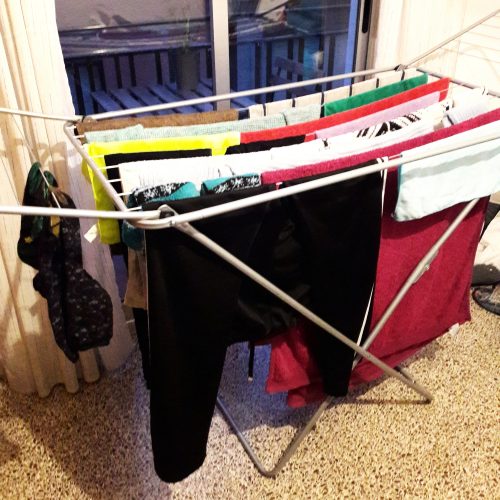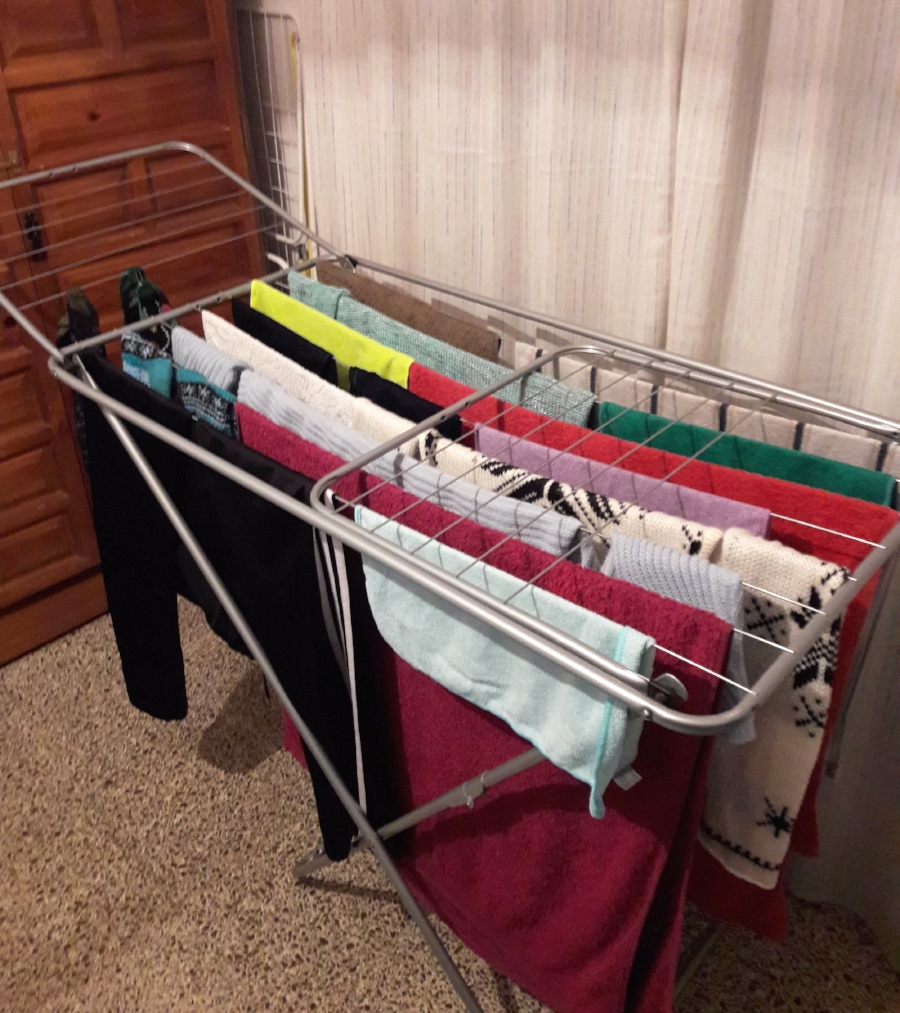
How to: Survive Without a Dryer
Please Note: This post contains affiliate links to products, Which means that we may receive a commission for purchases. For more information, see our disclosures here. Thanks for your support!
Dear Laine,
It may have come to your attention by now if you are already living abroad in Spain that at-home dryers are a real rarity. It feels strange, especially coming from a place like the US where this is considered a staple appliance, however I assure you this is quite normal in Spain. I have actually yet to meet anyone who has a dryer at home (at least here in the south of the country)!
Instead of having another machine that uses up a lot electricity, the norm is to simply hang your clothes out to dry or tender la ropa. For this reason, is it common to see not only sheets but clothing and undergarments hung on the line outside of apartment windows or on terraces/balconies. Every apartment I’ve lived in here in Granada has also come stocked with a tendedero, which is a foldable metal contraption that can be used indoors or outdoors to hang your clothes to dry, then conveniently tucked away. While it all seemed like quite a pain at the beginning, I have since adjusted my laundry-related habits and I know you can too!
Here are some thing to keep in mind in order to have a headache-free experience sans dryer:
 1.) Plan ahead: I find it quite ironic that, in this aspect of life, Spanish culture has taught me to be a better planner (as typically I’ve had to adapt to their lack of planning)! Without a dryer, you can’t leave your washing till the very last minute. In the heat of the summer, you can sometimes do laundry in the morning and have sun-dried clothes ready-to-be-worn by the evening. However, in the winter it can take up to four or five days for thick fabrics to finally dry! Plan to wash your clothes at least three days before you’re going on a trip, need a certain outfit, or are going to run out of undies!
1.) Plan ahead: I find it quite ironic that, in this aspect of life, Spanish culture has taught me to be a better planner (as typically I’ve had to adapt to their lack of planning)! Without a dryer, you can’t leave your washing till the very last minute. In the heat of the summer, you can sometimes do laundry in the morning and have sun-dried clothes ready-to-be-worn by the evening. However, in the winter it can take up to four or five days for thick fabrics to finally dry! Plan to wash your clothes at least three days before you’re going on a trip, need a certain outfit, or are going to run out of undies!
Pro-Tip: Although I tend to use my tendedero indoors (probably due to my American-influence modesty), I recommend hanging your clothes outside when in a time-crunch. The more direct sun and wind, the better…just be sure to check that the forecast isn’t calling for rain!
2.) Separate strategically, not by color: Moms everywhere will probably cringe at this tip, but I honestly have learned to forego everything my mom taught me about washing by color. Outside of brand-new clothes that are likely to ‘bleed,’ I’ve simply never had a problem with mixing lights and darks. On the other hand, it’s really useful not to wash EVERY pair of pants or EVERY plain white tee that you have at the same time because you’ll need something to wear during the interim.
Pro-Tip: I still tend to wash more delicate clothing and then more durable clothing separately, but it’s important to note that if you have nothing but bulky sweaters, jeans, and towels on your tendedero, it will take extra long to dry.
3.) Be mindful about how you hang your clothes: If you hang your clothes on the tendedero inside, it is not necessary to use any clothespins, but you will definitely want to do so on an outdoor line or if you place your tendedero on the balcony (unless you enjoy knocking on neighbor’s doors and asking if you can retrieve your Super Mario boxers). Keep in mind that tendederos and clothes line often leave a crease on your clothes so you may want to consider hanging blouses or nice shirts from a hanger instead. If you do any hand-washing, be sure to remove as much water as possible and drape your clothes over a couple spindles of the tendedero instead of just one to avoid the weight of its dampness from stretching out the fabric too much.
Pro-Tip: Most articles will stay put with one clothespin, but it’s not a bad idea to somewhat overlap shirts and share a pin (also helps lessen the indentation that often lingers after drying). I personally like to safety-pin my socks together and secure them with just one pin.
 4.) If all else fails, find yourself a laundromat: I don’t recommend this on a regular basis, but when I’m in a pinch it has come in handy. This option is not ideal as laundromats, or lavanderías, are not incredibly common in Spain either*. However, you can find them, and you probably don’t need to bring any laundry detergent or softener as these products are often dispensed automatically by the washing machines.
4.) If all else fails, find yourself a laundromat: I don’t recommend this on a regular basis, but when I’m in a pinch it has come in handy. This option is not ideal as laundromats, or lavanderías, are not incredibly common in Spain either*. However, you can find them, and you probably don’t need to bring any laundry detergent or softener as these products are often dispensed automatically by the washing machines.
Pro-Tip: If you have a perfectly-functioning washing machine at home and are simply in need of some quick drying, you might also consider taking your pre-washed clothes to the laundromat to be tumble dried. This will typically only cost you about 3€ per load (compared with the 7€+ that it would cost to wash and dry).
So, those are my tips! Can you think of anything else that might be useful? Has the lack of dryers been bothering you or do you like Spain’s hang-drying ways?
Sincerely,
Spain
*I seriously overheard a middle-aged women pointing out the laundromat to her parents the other day saying “Look, now we even have these…trying to be like other countries…” so I am quite sure this is not a Spanish costumbre. Still, I find that all cities tend to have a few nowadays, especially if you’re in a tourist location. However, you may want to look it up before wandering out in search of one with all your clothes in tow.





4 Comments
Kevin_roger@yahoo.co.uk
Seems odd that you seem to be confusing "tendero" (shopkeeper) with "tendedero" (clothes drier) . . .
Sincerely, Spain
Thanks for that catch, Kevin. The mistake has been corrected!
kworkwoman@gmail.com
This way of drying clothes is customary in Sweden too. My daughter was prepared for it when she moved to Sweden because I gave up using a dryer here in the States about 20 years ago. My husband worked nights and slept days so the noise of the dryer bothered his sleep. It’s much more pleasant to hear the birds singing!
Sincerely, Spain
Thank you for sharing your experience Kathleen!
In comparison to the U.S., many Europeans line dry their clothes instead of using a dryer.